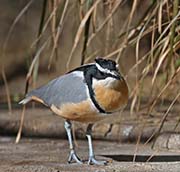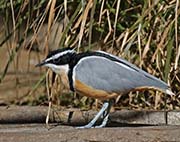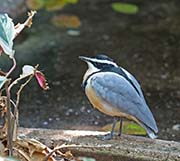Egyptian Plover - Pluvianus aegyptius
| Length | |
| Wingspan | |
| Weight | |
| Clutch Size | |
| Chicks at birth | |
| IUCN Conservation Status | |
Continents: |
The Egyptian Plover is found in sub-Saharan Africa. genus.
The Egyptian Plover is a striking bird. The underparts are a light orange and the upperparts are gray. The head is white with a black crown and a wide black stripe from goes from the black bill to the nape. They also have a black breast band with a white border. The flight feathers are a brilliant white crossed by a black bar. From below, the flying bird is entirely white, apart from the orange belly and the black wing bar. The legs are blue-grey, and the eyes black. Both sexes are similar. Juveniles are duller and the black marking are intermixed with brown.
The Egyptian Plover is also called the 'crocodile bird' because during the 5th century BC it was reported that the Plover would pick food from the teeth of gaping crocodiles. The story has never been proven as in undoubtedly a myth.
Diet: Egyptian Plovers eat mostly insects (both aquatic and terrestrial), worms, molluscs and seeds. Breeding site The nest is a deep scrape where the eggs are incubated by being buried in warm sand on an exposed sandbank in a riverbed
Courtship: Egyptian Plovers usually are found in pairs or small groups when not breeding. During the breeding season, they break up into solitary pairs. They breed on sandbars in large rivers.
Nesting: Egyptian Plover nests are usually a deep scrape in sand bars. The 2-3 eggs are laid in the scrape and then covered with warm sand. This provides the incubation needed for the eggs to hatch. If the weather gets too hot, the eggs are cooled down by wetting them with water captured on the belly of the parent. The chicks are precocial at birth and can run as soon as they are hatched. The chicks can quickly feed themselves.
Habitat and Range: Egyptian Plovers are found in sub-Saharan Africa to Northern Zaire. They inhabit lowland river with sand and gravel bars. They will inhabit areas around human settlements and occasionally use other wetland habitats (e.g. lakes or ponds).
Vocalization: The call is a high-pitched krrr-krrr-krrr.
Plumage/Molt No alternative or breeding plumage. Probably molts annually.
Migration: Egyptian Plovers are largely sedentary but will undertake local irregular nomadic movements or migration in response to changes in river water levels.
Tongue/feet:
Bibliography:
- http://en.wikipedia.org The Free Encyclopedia, Accessed July, 2012
- http://birdlife.org BirdLife International, Accessed July, 2012




